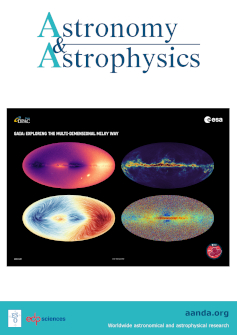Mrk 231中潜在的双星超大质量黑洞系统的偏振观测
IF 5.4
2区 物理与天体物理
Q1 ASTRONOMY & ASTROPHYSICS
引用次数: 0
摘要
上下文。马卡良231 (Mrk 231)是迄今为止已知的最亮的超发光红外星系(ulrgs)之一。它显示出独特的光紫外光谱,其特征是在近紫外波段有强烈而复杂的衰减,并伴有一个突然的极化峰。这项研究的目的是通过研究Mrk 231核心可能存在的双星超大质量黑洞(SMBH)系统,来澄清其令人困惑的光谱性质。为此,我们将先前研究中使用的光度信息与档案偏振数据结合起来,为类星体的结构和发射机制提供了更全面的方法。特别是,我们评估了二元SMBH模型作为近紫外截止的潜在解释,同时首次探索了该源的偏振响应。在之前的光谱光度模型的基础上,我们研究了Mrk 231核心可能存在双星SMBH系统的假设。在这种情况下,主要的,更大质量的SMBH的吸积盘负责光学紫外光谱。次级星系的圆盘,质量较小的SMBH,预计基本上会发射远紫外线。我们将该模型应用于Mrk 231的档案光度和偏振数据,并试图获得最佳拟合。为了支持我们的发现,我们进行了辐射传输计算,以确定构成Mrk 231的每个主要成分的空间分布。我们发现二元SMBH模型可以很好地再现Mrk 231的通量和极化。我们推断,该核心可能拥有一个双SMBH系统,主SMBH的质量约为1.6 × 108 M⊙,次SMBH的质量约为1.1 × 107 M⊙,由约146 AU的半长轴分隔。次级SMBH在0.1 ~ 0.2 μm之间驱动约3%的偏振度,对应的偏振位角约为134°,这与吸积盘内的散射一致。初级SMBH及其周围的结构造成了0.3 ~ 0.4 μm之间约23%的偏振度,对应的偏振位置角约为96°,这可能是类星体风内部散射造成的。最后,我们的模型预测了远紫外偏振通量的第二个峰值的存在,这是一个可以明确证明双星smbb存在的标志。这些结果有力地支持了Mrk 231中存在双SMBH的假设,并强调需要新的远紫外分光偏振仪来清晰地探测附近类星体中存在的亚秒差距双SMBH。本文章由计算机程序翻译,如有差异,请以英文原文为准。
Polarimetric insights into a potential binary supermassive black hole system in Mrk 231
Context. Markarian 231 (Mrk 231) is one of the brightest ultraluminous infrared galaxies (ULIRGs) known to date. It displays a unique optical-ultraviolet (optical-UV) spectrum, characterized by a strong and perplexing attenuation in the near-UV, associated with a sudden polarization peak.Aims. The aim of this study is to clarify the puzzling nature of Mrk 231’s spectrum by examining the potential existence of a binary supermassive black hole (SMBH) system in its core. To this end, we combined photometric information used in prior studies, with archival polarimetric data to provide a more thorough approach to the quasar’s structure and emission mechanisms. In particular, we evaluated the binary SMBH model as a potential explanation for the near-UV cutoff, while exploring its polarization response, for this source, for the first time.Methods. Building on previous spectro-photometric modeling, we investigated the hypothesis that the core of Mrk 231 may host a binary SMBH system. In this scenario, the accretion disk of the primary, more massive SMBH is responsible for the optical-UV spectrum. The disk of the secondary, less massive SMBH, would be expected to essentially emit in the far-UV. We applied this model to archival photometric and polarimetric data of Mrk 231 and tried to obtain the best fit possible. To support our findings, we performed radiative transfer calculations to determine the spatial disposition of each main component constituting Mrk 231.Results. We find that a binary SMBH model can reproduce both the observed flux and polarization of Mrk 231 remarkably well. We infer that the core potentially hosts a binary SMBH system, with a primary SMBH of about 1.6 × 108 M⊙ and a secondary of about 1.1 × 107 M⊙, separated by a semimajor axis of ∼146 AU. The secondary SMBH drives a degree of polarization of ∼3% between 0.1 and 0.2 μm, with a corresponding polarization position angle of about 134°, which is consistent with scattering within an accretion disk. The primary SMBH and the structure around it are responsible for a degree of polarization of ∼23% between 0.3 and 0.4 μm with a corresponding polarization position angle of about 96°, that is possibly attributed to scattering within the quasar’s wind. Finally, our model predicts the existence of a second peak in polarized flux in the far-ultraviolet, a telltale signature that could definitively prove the presence of a binary SMBH.Conclusions. These results strongly support the hypothesis of a binary SMBH in Mrk 231 and emphasizes the need for new far-ultraviolet spectropolarimeters to clearly detect the existence of subparsec binary SMBHs in nearby quasars.
求助全文
通过发布文献求助,成功后即可免费获取论文全文。
去求助
来源期刊

Astronomy & Astrophysics
地学天文-天文与天体物理
CiteScore
10.20
自引率
27.70%
发文量
2105
审稿时长
1-2 weeks
期刊介绍:
Astronomy & Astrophysics is an international Journal that publishes papers on all aspects of astronomy and astrophysics (theoretical, observational, and instrumental) independently of the techniques used to obtain the results.
 求助内容:
求助内容: 应助结果提醒方式:
应助结果提醒方式:


